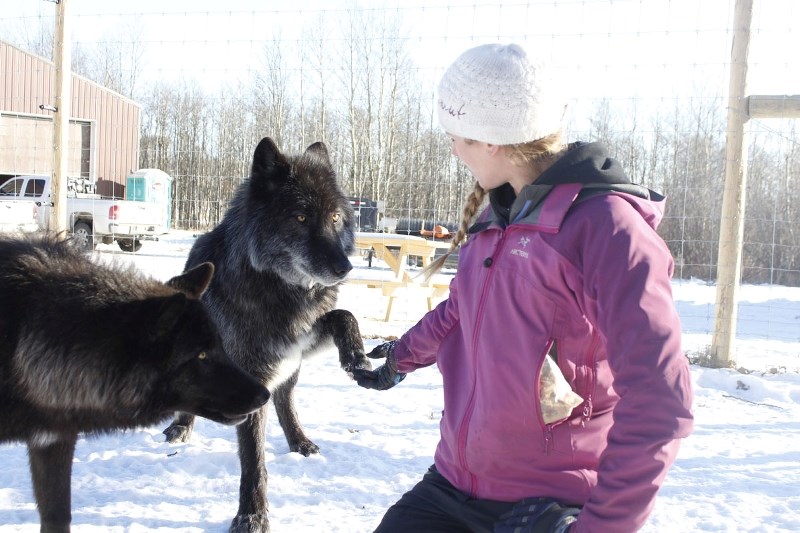When thinking of Cochrane-specific businesses, events and tourist attractions, it’s more than likely that MacKay’s Ice Cream, the Outhouse Races and the Historic Cochrane Ranche site would come to mind.
But a wolfdog sanctuary?
Since April of this year, the Yamnuska Wolfdog Sanctuary has made its home in rural Cochrane, located on 160 acres west of Hwy 1A off of Range Rd. 53.
Formerly located in Kananaskis Country, the sanctuary ran into permit issues and reopened at its new location this year.
It is the only official rescue facility for wolfdogs in the province and is one of Cochrane’s newest tourist attractions.
With the approaching intake of five more wolfdogs from a Washington sanctuary forced to downsize, the facility is looking for assistance through donations, as well as tour bookings to ensure the over $35,000 facility expansion doesn’t put too much pressure on the non-profit charitable organization — which is mainly funded through private tours.
“I think one of the biggest challenges is that there’s no breed standard, which leaves the door open for a lot of misconstrued information,” explained Georgina De Caigny, who started the non-profit with her mother, Andi Scheibenstock, in 2011 — but has taken over the reigns as facility operator.
Although she holds a degree in civil engineering, De Caigny’s passion for rescuing wolfdogs has fueled her current career choice, ignited some 13 years ago through working at a Canmore sled dog kennel that housed some of the animals.
Wolfdogs are the result of wolves and dogs intentionally bred together.
Lineage purity is nearly impossible to detect, but the most common dog breeds bred with wolves or wolfdogs are huskies, malamutes and shepherds; they are bred for entertainment (movies) and for private homes and are sold anywhere from $1,000-$5,000.
The facility operator took the Eagle for a tour of her sanctuary, including in the enclosure to hand-feed and photograph the mid-high content wolfdogs. The animals ranged from cautious to very affectionate and there were no visible signs of aggression.
De Caigny said when talking about wolfdogs, it’s key to remember a few points: that percentages are not reliable and these animals are better categorized as low/medium/high-content wolfdogs (referring to the degree of wolf in the dogs); that questionable backyard breeding has resulted in a lot of wolfdog owners believing they have mid-high content wolfdogs, when in reality 95 per cent of all wolfdogs in Alberta are either zero-low content wolf; and that wolfdogs can never be handled or assumed to behave like a ‘normal’ dog.
De Caigny establishes the content of wolf in her wolfdogs through phenotyping — examining physical and behavioural characteristics.
De Caigny said the 10 wolfdogs in her care (currently five mid-high content and five zero-low content, with another five high-content wolfdogs to be added to the mix) are all ‘the result of humans intentionally breeding them’.
She currently has two low-content wolfdogs ready to be re-homed; the mid-high content wolfdogs will live out their days at her facility.
She explained that it’s very rare for dogs and wolves to breed naturally in the wild, based largely on two factors: that wolves are a pack animal that are far more likely to kill a dog, rather than breed with it, and that wolves are only fertile December through February.
Their instinctual fear of humans and their tendency to roam or break free of enclosures are two characteristics many wolfdog owners fail to understand. The more wolf content in the animal, the more pronounced these characteristics are — often resulting in these animals being euthanized, since regular shelters don’t have the resources to care for them and mid-high content wolfdogs are rarely suitable for re-homing.
De Caigny said it’s common for backyard breeders to perpetuate the myth that a wolfdog ‘looks like a wolf, but behaves like a dog’.
Due to their innate fear of humans, this is simply not the case, especially for mid-high content wolfdogs.
The quarter section the wolfdogs reside within is enclosed with eight-foot high wire fencing, curved at the top, as containment is of top priority.
To accommodate the five from south of the border, De Caigny has hired a private fence contractor to build three half-acre enclosures.
She is currently welding crates together for transport of the five new wolfdogs — which she will be bringing to their new home at the end of the month; the crates cannot be wooden or glass, as the wolfdogs would destroy them.
The trip to bring the five wolfdogs home will take upwards of 20 hours and will be a grueling, traumatic journey for the animals — who are fearful of loud noises and unfamiliar surroundings.
Wolfdogs are legal in Alberta, as long as the animal is a hybrid (not pure wolf); they are also legal in B.C.
De Caigny works closely with Calgary Animal Services, the Calgary Humane Society and other dog rescue societies.
To learn more, visit yamnuskawolfdogsanctuary.com. Tours are $39/person for those aged 12 and up.



